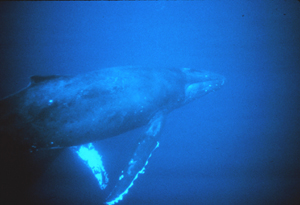 |
 |
 |
 |
 |
 |
 |
 |
 |
 |
|
|
  |

|
|
Home > Environmental Issues > Article > |
||

The conflict of mineral mining in a whale sanctuary20 November 2005Whales within the New Zealand Exclusive Economic Zone, which covers more than 4 million sq.km. of ocean, are protected from being killed by the harpoon under the Marine Mammals Protection Act 1978. There is no protection of whales from the impacts of anthropogenic sound generated by shipping, seismic surveys for oil and gas exploration and mineral prospecting, exploration drilling, and drilling, blasting and extraction of minerals. The pursuit of these activities raises the issue of impact on whales migrating along New Zealand's coastal waters where oil and gas exploration is active, and the seamounts of the Kermadec Ridge where mineral prospecting is being carried out. Whales are presently protected in the very south of the Pacific Ocean and the Southern Ocean from commercial whaling in the Southern Ocean Whale Sanctuary established by the International Whaling Commission (IWC) in 1994. It covers all waters surrounding Antarctica, northwards to latitude 60deg South in some regions, and to latitude 40deg South in the New Zealand region. The sanctuary protects feeding grounds of 75 percent of the world's whales. A second whale sanctuary has effectively been established - not by the IWC - but by whale protection legislation of 12 South Pacific states and territories, covering a continuous area of 12 million sq.km from Australia to French Polynesia. The effective sanctuary stretches across the entire EEZs of Australia, New Zealand, Papua New Guinea, New Caledonia, Vanuatu, Fiji, Tonga, Samoa, American Samoa, Niue, Cook Islands, and French Polynesia. Much of the area provides winter breeding grounds in tropical waters for many whale species. The New Zealand EEZ is a critical protected area for whale migration, linking the Southern Ocean Whale Sanctuary with the protected EEZs of the Pacific island states and territories. With the exception of a small area between the northen end of the New Zealand EEZ on the Kermadec Ridge, and the southern perimeter of Tonga's EEZ, the migration path is protected from commercial whaling. Protection extends through the Southern Ocean Whale Sanctuary to its northern boundary at 40deg South latitude, which is in the region of the southern North Island, and through the northern half of the New Zealand EEZ. Memorandum of Understanding (MoU) on the Conservation and Management of Cetaceans and their Habitat in the Pacific Islands Region New Zealand has one of the world's highest rates of whale strandings. International obligations ........ New Zealand, a 1946 founding member of the International Whaling Commission (IWC), when there was an active domestic whaling industry, is now regarded as one of the staunchest advocates of whale conservation. The Department of Conservation was a strong supporter of the Commission's establishment in 1994 of the Southern Ocean Whale Sanctuary, which includes all of the New Zealand exclusive economic zone south of 40¡S. The department leads New Zealand's participation at the IWC's Scientific Committee and is represented on the New Zealand delegation to the meetings of the Commission. The Department provides advice and, where necessary, representation at meetings of international conventions with an interest in marine mammals, such as the Convention for the Conservation of Antarctic Marine Living Resources (CCAMLR). New Zealand and Australia have made a proposal to the IWC for the South Pacific Whale Sanctuary, which would incorporate the national whale sanctuaries of the twelve states and territories, and other areas in 9 territories that are not yet protected. The proposed South Pacific Whale Sanctuary would extend from the equator to 40deg latitude South, and from mid-Australia to beyond the Pitcairn Islands, forming a continuous protected area from the equator to Antarctica. Countries with whale-watching industries are interdependent on one another.It is a well-established scientific principle that, to protect migratory species, it is necessary to protect their breeding grounds as well as their feeding areas and migratory routes. In this respect, the South Pacific Sanctuary complements and improves the effectiveness of the Southern Ocean Sanctuary. Seismic operations, such as the use of air guns in oil and gas surveys, may also disturb the natural activities of these species. Great whales are especially sensitive while mating and calving, their primary reasons for migrating to the area. Military exercises involving sonar can also interrupt whalesÕ critical migratory and breeding patterns. What we're hoping is that the coincidence we've seen of whales around sites where we've got shallow volcanoes could indicate that there is actually enhancement occurring there of nutrients, and therefore of plankton and the whole food chain." |
||
The Scientific Committee views with great concern the impacts on large whales in critical habitats from exposures to seismic sound impulses. |
||
|
The Committee also concluded that evidence of increased sounds from other sources, including ships and seismic activities, were cause for serious concern. In respones to its concern over seismic operations, the IWC Scientific Committee has established mitigation and monitoring protocols, which it commends to IWC member governments. Effort should be expended on the global identification and monitoring of critical habitats for cetaceans. |
||
|
Access should be given to information on the timing, distribution, extent, sound source, and sound source characteristics for past and planned seismic surveys carried out within the range of critical habitats or potential critical habitats. Descriptions and results of any marine mammal observer programmes or other faunal observation programmes carried out in conjunction with previous seismic surveys. The continuous acoustical monitoring of critical habitats on sufficient temporal and spatial scales in relation to pre- and post seismic activity. |
|
|
That same year, adult humpback whales were reported to have stranded in unusually high numbers along Brazil's Abrolhos Banks, where oil and gas surveys were conducted.[5] Studies suggest that critically endangered western Pacific grey whales were displaced from important feeding grounds and exhibited behavioral changes in response to seismic surveys off Russia's Sakhalin Island.[6] Other marine mammal species known to be affected by airgun arrays include sperm whales, whose distribution in the northern Gulf of Mexico has been observed to change in response to seismic operations; bowhead whales, which have been shown to avoid survey vessels to a distance of more than twenty kilometers while migrating off the Alaskan coast; and harbor porpoises, which have been seen to engage in dramatic avoidance responses.[7] Although most research to date has been devoted to marine mammals, seismic exploration is a problem whose impacts affect a wide range of species, including sea turtles. Loggerhead turtles have been shown to alter their swimming in response to airgun noise, and there is concern that intense noise may drive them and other species to the surface, where they are more vulnerable to ship strikes and predation. Given their swimming patterns, the amount of time they spend underwater, and the difficulty of spotting them from the deck of a seismic ship, it is also feared that these species would be exposed to the highest levels of sound.[8] In January-February 2004, over thirty endangered sea turtles washed up on the beaches of the Yucatan, Mexico, following seismic testing conducted by PEMEX, suggesting that, like marine mammals and other species, sea turtles are driven to strand by intense anthropogenic sound.[9] Impacts on commercial species of fish have also been shown. In one series of studies, it was demonstrated that airguns can cause extensive and apparently irreversible damage to the inner ears of pink snapper - damage severe enough to compromise survival - even at exposure levels that might occur several kilometers from a source.[10] Other studies suggest strong behavioral reactions. In Norway, for example, catch rates of cod and haddock fell dramatically (between 45 and 70% in the vicinity of an air gun array, affecting fisherman across an area nearly 5000 sq km in size, and did not recover within five days after operatons ended.[11] Researchers have also begun to investigate the impacts of seismic on invertebrates. According to one current study, two multiple giant squid strandings off the coast of Spain appear to be linked spatially and temporally to the use of air guns there; the squid showed lesions that have never before been seen in the species.[12] Meanwhile, a preliminary report out of Canada suggests that airguns can physically injure snow crabs.[13] Studies such as these have begun to outline the dimensions of the risk that seismic work entails. It is clear that seismic surveys risk widespread injury and disturbance of diverse marine species, from the largest whales, to dolphins and other marine mammals, to numerous species of fish, to invertebrates such as squid and crabs. Countries can and should work to ensure that seismic exploration surveys in their waters are conducted in ways that lessen these harms. |
||

The diversity of whales around New Zealand coastsThe New Zealand public has a great fondness for half of the world's 80 species of whale, and the highest number of beaked whales, that can be found around the coasts of New Zealand. This impressive group consists of 30 species of toothed whales including 10 dolphins and a porpoise, and 8 baleen whale species. New Zealanders took great pride in the strong position the country took at the IWC meeting in June 2005, in opposing Japan's unsuccesful attempt to end the embargo on commercial whaling, and to double its kill to 900 minke whales, and add 50 fin and 20 humpback whales, for alleged scientific research. The Minister of Conservation Chris Carter said the IWC vote "... means that Japan has no moral authority to go whaling in the southern ocean ... it is a statement that the majority of countries at the IWC do not support scientific whaling ..." The Minister says the IWC is in need of a major overhaul, because there is no disputes resolution process, and no penalties for countries that break the rules.
|
|
Coastal States have the obligation under the United Nations Convention of the Law of the Sea (UNCLOS) to protect and preserve the marine environment. The Convention recognises the sovereign right to exploit natural resources, but adds that it is pursuant to environmental policies and in accordance with the duty to protect and preserve the marine environment. It is clearly apparent that mineral mining of the deep seabed is proceeding without any established New Zealand marine environmental protection policy. UNCLOS goes further in stating that measures shall include those necessary to protect and preserve rare or fragile ecosystems. Neptune mining operations target sulphide deposits on seamounts and around hydrothermal vents. These habitats must surely be regarded as rare and fragile, because of their dynamic nature as centers of irradiation of species towards virgin seabed areas, ancient coral forests, a high rate of endemism at separate locations, and extreme environments containing organisms that live in temperatures of 30-80degC. |
TerraNature Trustee Dr David Given points out that "one way of looking at such deep-sea areas is to regard them as the marine equivalent of Antarctica". "Just as New Zealand has been a major player in both the formation of the Antarctic Treaty system and the minerals extraction moratorium for the Antarctic, so there is opportunity for New Zealand to ensure that this last great frontier for science and last great wilderness area - the deep sea systems - is protected as a unique asset for future generations and because of its unique intrinsic worth". |
There is worldwide concern for the protection of seamounts that goes beyond prospecting and mining. The issue of conflicting uses was addressed in the UN Secretary-General's annual report to the 58th session of the General Assembly, which called for the need to clarify aspects of the regime for marine science research (MSR), including the distinction between pure and applied science, and how to address marine genetic resources. The report highlighted conflicting uses of the deep seabed between pure MSR, mineral prospecting, bioprospecting, and conservation. The annual report to the 58th General Assembly in 2003 identified MSR as a specific threat to hydrothermal vents. These environments are that sensitive that excessive sampling is regarded as harmful. In 2001, the Labour government established a goal of putting 10 percent of New Zealand's ocean area, including the territorial sea and the EEZ, within marine protected areas by 2010. A total area of 760,368ha in 16 marine reserves was established in the territorial sea before Labour's policy from 1974 until 1999. Following that period, and since Labour's announcement of its 10 percent goal in 2001, only one 690ha reserve has been established by order in council. Another three reserves covering 534,000ha have been approved by the Minister of Conservation, but await the approval of other Ministers. No reserves can be designated in the EEZ until passage of the Marine Reserves Bill which was introduced into Parliament in 2002. This poor performance record of meeting marine reserve goals, reflects the difficulty different branches of government appear to be having in working together to meet common ocean management goals. |
 Conflicting uses with New Zealand control of its ocean territory
Conflicting uses with New Zealand control of its ocean territory

 TerraNature has addressed the need for protection
of seamounts, legislation to regulate all uses in the EEZ, and to stop mining in locations
with potentially invaluable ecosystems in a letter to Prime Minister Helen Clark.
TerraNature has addressed the need for protection
of seamounts, legislation to regulate all uses in the EEZ, and to stop mining in locations
with potentially invaluable ecosystems in a letter to Prime Minister Helen Clark.